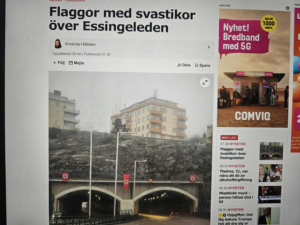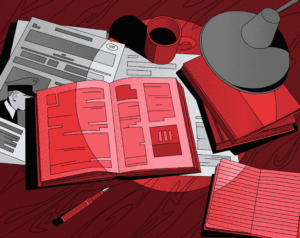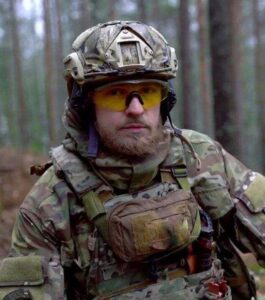This article is part 1 of 7 in the Hammerskins Series. This series was originally published in German via Exif – Recherche & Analyse, and gives us an in-depth look into one of the oldest and most stable neo-Nazi organisations worldwide. This first part of the series draws a larger picture of the network, its history, and its organisational infrastructure.
Part 2 explains the identity of Hammerskins and its members, their rules and codes, as well as symbols and visuals they deploy. Part 3 gives a detailed account and explanation of their engagement in criminal activities, such as murder and terror attacks. All their activities are funded via multiple streams of revenue, which Part 4 analyses. Part 5 sheds light on the role of Hammerskins in the ‘NSU Complex’. Part 6 delves into the transnational aspect of the organisation and associated problems they face because of it. The final part of the series, Part 7, focuses on the failure of German intelligence services to identify Hammerskins as an influential actor within right-wing extremism in Germany and worldwide. One central goal of this series is to drag Hammerskins workings out of the shadows and give possibility to the developing of counter-strategies, which so far seemingly has not happened.
The Hammerskins are one of the oldest and most stable neo-Nazi organisations in the world. Founded over thirty years ago, the tightly organised brotherhood considers itself the “elite” of the neo-Nazi scene. It is a sworn community that rallies under the Hammerskin Nation banner, which serves as an overarching structure uniting Hammerskins from Europe, the US and New Zealand. Their activities cover a broad range of areas, and their members are among the driving forces of the militant neo-Nazi scene.
Hammerskins are hardly ever in the media spotlight. Their behaviour is conspiratorial, their structures are closed off to outsiders and remain clandestine. Public visibility, in their view, would only restrict the scope of their activities: earning profits and engaging in political propaganda and networking through right-wing rock music, making preparations for “Day X”, including shooting exercises at home and abroad, and the advancement of their political goals complete with all the consequences this entails, including right-wing terrorist attacks.
In 2012, a Hammerskin shot dead six people and injured several more in the US. In 2020, one of the victims died from the sequelae of the attack. The assassin had close ties to the scene in Germany. The German domestic secret service (Verfassungsschutz), which claims to serve as ‘democracy’s early warning system’, has been trivialising the organisation for over 30 years—not least to protect its informants in the scene, several of whom have been exposed to this day.
Publicly exposing a right-wing extremist network can scare people—in particular the (potential) victims of right-wing violence. But let us not forget that such fears are already a reality for many people, and, indeed, motivate their struggle.
The intentional withholding of information by government agencies creates the image of an abstract danger and makes it harder for people to respond independently and fight back.
Hammerskins promote their racist and inhuman views throughout society, often living in middle-class neighbourhoods and working in respectable professions, sometimes even in executive positions. Our hope is that, by publishing information and analytically contextualising it, we can help people develop strategies to deal with a mostly diffuse threat.
On the following pages, we describe Hammerskin activities and their continuities, seeking to present a comprehensive overview of the network and the organisation’s infrastructure. Such a detailed inspection should help unravel the myth that provides the basis for the reputation the group has gained in the white supremacist scene. Contradictions and weak spots do exist, however, and the Hammerskins are vulnerable, especially if their actions are dragged into the public limelight.
Founding and expansion
Towards the end of the 1970s, ruptures and factionalism emerged within the growing skinhead scene. While the movement had repeatedly positioned itself as patriotic, only a very small minority were explicitly neo-Nazi. The English punk-turned-white-supremacist musician Ian Stuart Donaldson, an iconic figure in the scene, and his band “Skrewdriver” would abruptly change this.
From the mid-1980s onwards, skinhead culture as a whole became politicised. US skinheads, too, became politicised and radicalised and began organising in gang-like groups at the local level, claiming a certain territory and then defending it through violent actions.
Street violence affected not only groups defined by racial criteria or those deemed political opponents, the victims also included members of other neo-Nazi skinhead groups. Correspondingly, the term ‘gangland’ frequently appears in US reports from that time.
To put an end to violent conflict between skinhead groups, one such group from Dallas, Texas, decided to launch an attempt to unite existing gangs. In January 1988, together with neo-Nazis from Tulsa, Oklahoma, they formed the Confederate Hammerskins, the world’s first Hammerskin chapter. Tight organisational structures and determined commitment were to distinguish them from the rest of the scene—their aim was to represent the “elite”.
Very soon, neo-Nazis from other states rallied behind the concept and, by 1990, had formed offshoots in the Midwest, on the East Coast and in the South of the US.
Then as now, right-wing rock music served as a vehicle for promoting a shared identity and driving radicalisation, but also for communication. Bands became the white power movement’s mouthpiece, and concert venues became important sites for interaction and exchange.
In 1988, Ed Wolbank, the Northern Director of the Hammerskins, internationally known through his bands “The Bully Boys” and “Bound for Glory”, met Swiss neo-Nazi Patrik Iten. This meeting, and Wolbank’s subsequent support and backing, eventually resulted in the founding of the Swiss Hammerskin chapter, the Hammerskins’ European “mother chapter”, in 1990.
Then, in 1992, under the eager eye of the Swiss, Germany’s first chapter, the “Hammerskins Berlin”, was formed, followed by the “Saxony Chapter” a year later. In 1993 followed the “Bohemia Hammerskins” in the Czech Republic, the “Charlemagne Hammerskins” in France and the “Vinland Hammerskins” in Canada.
In 1994, after the founding of the “Hammerskins Nederland”, the “Hammerskins Bremen” and the “British Hammerskins”, the US chapters decided to create an umbrella organisation to streamline structures and secure control over setting the rules and standards for the admission of new branches: a uniform superstructure called the “Hammerskin Nation” (HSN), under which all chapters worldwide rally to this day.
The concept of the “brotherhood” and a structure akin to outlaw biker clubs was chosen intentionally, above all to distinguish the Hammerskins from the Blood & Honour network that had emerged in England in 1987.
Given its low entry threshold and subcultural appeal, the Blood & Honour network had also managed to unite neo-Nazi groups under its banner in a number of places but found itself struggling with in-fighting and factional rivalries. In the HSN model, by contrast, the chapters around the world regarded it as their obligation to seek internal solutions to internal problems. Not to mention complying with the duty to inform each other about developments and activities and to make decisions via directives (i.e. delegates).
In order to function as a network capable of making decisions at a European level as well, the Dutch Hammerskins pushed for regular meetings between delegates and, in 1996, convened the first meeting of European chapters in Italy. During that meeting, the HSN rules and regulations from the US—the ‘Hammerskin Constitution’—were presented alongside a strategy paper outlining the restructuring of the HSN in Europe.
In September 1997, the “Swiss Hammerskins” organised the “2nd Pan-European Assembly of Hammerskins Associations”. According to the invitation, one objective was ‘to form a root organisation—the mother section Europe—of all the sections present’.
These meetings were the forerunners of the “European Officers Meetings” (EOM), which take place several times a year and constitute the Hammerskins’ most important decision-making body in Europe. The decisions taken and discussions held during these meetings concern all European chapters.
Then, between 1995 and 2005, fascinated by the binding nature of such a structure, which saw itself as the elite of neo-Nazi skinheads, several further chapters were founded around the world.
In Germany, these included the chapters “Pomerania”, “Mecklenburg”, “Nordmark”, “Bavaria”, “Baden”, “Franconia” and “Westmark”. In Eastern Europe, too, neo-Nazis formed—partly ‘unauthorised’—HSN offshoots, but in 1999, and owed mainly to the chauvinism and racism of the Western European Hammerskins, the HSN dissolved all Eastern European branches. To this day, there is no officially approved chapter beyond the Oder and Neisse rivers on the eastern border of Germany. After several years of debate, only the members of the former Moscow Hammerskins chapter were recognised as a support group in 2012, and have since used the name “Crew 38 Moscow”.
The first ruptures within the European structure occurred in the late 1990s, preceded by disputes over the HSN’s orientation and role. Subsequently, the French branch “Charlemagne Hammerskins” and the Swiss chapter “Romandie” were excluded from the HSN in 1998. Only a year later, neo-Nazis in France re-grouped, forming the “France Hammerskins” chapter that exists to this day.
While the period until 2005 was marked by these upheavals, but, above all, by the rapid growth of the HSN, the group’s potential seemed to have been exhausted by 2014. The only newly founded chapters were the Hungarian Hammerskins, the Sweden Hammerskins and the Württemberg chapter in Germany. The British Hammerskins ceased all activities around 2009.
Also in 2009, due to their highly criminal activities and a number of racist attacks, charges were brought against the Hammerskins Espagna. The Spanish government classified the chapter as a criminal organisation and its head, Eduardo Chapela, was sentenced to several years in prison. Shortly after that, the German chapters also found themselves increasingly targeted by prosecutors. Sven Krüger from the Mecklenburg chapter was arrested after weapons were found in early 2011. And in November 2011, the core trio of the neo-fascist NSU terrorist group blew their cover. This was followed, in the summer of 2012, by the terrorist attack on a Sikh religious community in Wisconsin during which Hammerskin Wade Michael Page murdered several people.
In all of these cases, links to the Hammerskin Nation were found, and the “brothers” came into the focus of the public limelight. Allegations of support for right-wing terrorism were being made, prompting the HSN’s restructuring efforts designed to complicate any potential prosecution.
After anti-fascist groups publicised profound insights into the inner workings of the brotherhood in 2013, several (feigned) dissolutions of German chapters and resignations of members were declared and internal struggles erupted. The Westmark chapter disbanded, with the majority of its members being absorbed into the Westwall chapter. Activities of the Baden chapter were ceased in 2015, although some of its members continue to be HSN members. Attempts to form new chapters by former Westmark chapter members have failed. Only in the state of Saarland were the efforts successful, leading to the founding of the Sarregau chapter in 2019.
Seeking greater independence, Hammerskins in the Bochum area, who had been affiliated to the Bremen chapter up until then, founded the Westphalia chapter in 2014. A few years later, the Rhineland and Brandenburg chapters were founded. An earlier Brandenburg chapter had existed in the 1990s but was dissolved in the late 1990s following internal quarrels.
In 2014, the old French structure was also reorganised, leading to the formation of the chapters Lorraine, North France and South France were established. The same year, another new chapter, the Hammerskins Asturias, was established in Spain. It was part of a strategy to consolidate the growth of structures outside the greater Madrid area. In the Netherlands, too, around the year 2013, younger neo-Nazis began reviving the old structure that had existed until the mid-2000s. And, indeed, a handful of Dutch neo-Nazis have been self-identifying as Hammerskins once again since 2018. In addition, the HSN has expanded to Finland, where a chapter was formed in 2019, and, with the establishment of the Brazil chapter in 2020, to South America, too.
The HSN currently has 13 active chapters in Germany, 12 additional branches in other European countries, and 10 chapters outside of Europe. What makes the Hammerskins so unique within the broader neo-Nazi scene is the vast extent of their network and their ability to maintain decision-making structures at a global level.
Gang mentality to promote group cohesion
In the tradition of self-proclaimed elites, leading Hammerskins like Malte Redeker tried to set new standards. Concerts with up to 2,000 guests, as took place in France in July 2011, but also the annual HSN Hammerfest concerts were highly popular in the scene—not least because of their professional organisation, which has not least earned the Hammerskins a reputation as a pool of reliable service providers.
Beyond their own events, the Hammerskins make this structure available to others, too. Between 2013 and 2019, for example, members of the Italian chapter managed entrance and admission, security, technical equipment and the bar at the annual NS black metal Hot Shower Festival in Milan. At first, the festival even used the chapter’s clubhouse as a concert venue. That said, the Italian Hammerskins themselves never had any subcultural connection to this genre of extreme right-wing music.
In an attempt to explain the brotherhood’s role and impact at the Hot Shower Festival, Olia Coşkun quoted a concert participant in a guest article in the book Their Struggle by Robert Claus, as stating: ‘(…) why bother if there’s a well-staffed elite security service available, after all, I’m there to enjoy myself in my own special way and not to ensure “law and order”’.
The violent enforcement of HSN rules against people outside the group allows the latter to appear strong and united—a well-known phenomenon to anyone familiar with a gang mentality. Setting an example and creating a credible threat usually involves the use and display of excessive violence. In this sense, it is important to understand the Hammerskin brotherhood in terms of a street gang as well.
One Hammerskin self-described the organisation using the term ‘gang’: ‘For a friend or brother, I was and am always ready to give everything. If you don’t fuck with me, I will always stand with you. For me, true “love” exists only between men (…) My honest thoughts on the HS are as follows. I see the HS as a gang where it’s just us and our very close friends. I don’t care about the rest. I am not political, I just stand with those who would do the same for me. I see the HS as an alternative to today’s selfish and money-grubbing society.’ (sic!) Benjamin H., a former Swiss Hammerskin, gave this statement when addressing the HSN in the aftermath of his orgy of violence at the 2012 Hammerfest in France. He apologised because he had assaulted his ‘brothers’ and spoken badly of the HSN. His regret could not prevent his expulsion, however: according to the verdict, his behaviour had damaged the group’s reputation.
The HSN cannot tolerate such behaviour without risking being perceived as weak and on a par with other less well-structured organisations, from which the brotherhood precisely seeks to stand out.
According to its internal rules, the HSN is a brotherhood in which not everyone has to agree at all times, but where members are encouraged to resolve problems with other “brothers” constructively and “for the good of the nation”.
‘Don’t interfere in other people’s quarrels and do not ally yourself with your brother’s enemy. It is the duty of the Hammerskin to unite the white nationalist forces’ (sic!), the manual of the European Hammerskins at the turn of the millennium stated.
Or, as the Saxony Hammerskins put it: ‘We do not tolerate antisocial behaviour in our ranks, the Hammerskins are an elite organization and have to distinguish ourselves from the mainstream’.
Slogans like ‘All for one—one for all’ not only suggest mutual commitment but ultimately entail the principle of ‘Touch one, touch all’. If you attack a member of the organisation, the entire organisation will be after you. It is what makes being in a gang so appealing and is a persistent principle evident in many of the narratives surrounding individual chapters.
Admittedly, certain regional chapters of the brotherhood with only a few members may seem insignificant per se. And, to a certain extent, the question appears legitimate: what is so dangerous about five neo-Nazis sitting in a garden shed wearing their crossed hammer bomber jackets and enjoying the pathos-laden life of the brotherhood on a Saturday afternoon? A question that the authorities initially considered as well, but only to decide that they were simply irrelevant because of their alleged ‘lack of public visibility’.
Such an assessment fails to acknowledge that the Hammerskins intentionally refrain from doing just that. In some places, the elaboration of an almost mythical legend surrounding the brotherhood alone suffices to cause fear.
There is no question that some regional offshoots are no more than the product of wishful thinking rather than genuine chapters, using the Hammerskin label to appear larger. But it must never be forgotten, even the Hammerskin sitting in his garden shed with his two “brothers” in a village of 300 people somewhere in Saxony is always on stand-by to support the cause—i.e. neo-Nazi activities or even fascist terror.







